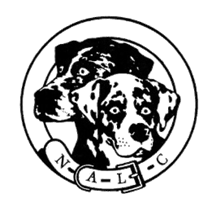NALC Official Standard for the Louisiana Catahoula Leopard Dog
Origin & Purpose
The Louisiana Catahoula originated in the territory of Louisiana, USA. The dog is used as a stock dog, bay dog, tree dog, companion dog, watch and guard dog.
General Appearance
The Louisiana Catahoula is a medium to medium-large dog, well-muscled, yet trim. It is powerful, but denotes agility and great endurance.
Temperament
The Catahoula is independent, protective, and territorial. It may show aggressive behavior. Signs of timidity on a leash should not be taken as cowardice, but the intolerance for strangers.
Size
Males should measure 22-26 inches (55.8 cm – 66.0 cm).
Females should measure 20-24 inches (50.8 cm – 60.9 cm).
Coat & Color
The coat length should be short to medium. Leopards are preferred and may come in blue, gray, black, tan, liver, red, white and patched. Trim may be black, white, tan, red, or buff. Solid colors acceptable are black, yellow, red, and chocolate. Disqualification: Long or fuzzy coated dogs.
Head
The head should be powerfully built with well-developed cheeks. Skull: Broad top-skull with well-defined stop being moderate in length. Eyes: Glass eyes are preferred, although the eyes may be of any color or combination of colors. The eyes do not have to be the same color and may have partial glass in one or both eyes, commonly called “cracks”. Serious Fault: Any malformed or acentric pupil formation of the eyes. Ears: The ears should be medium in length with the base of the ear being set level or slightly below the top of the head. Properly hung ears, with the inner edge of the ear lying close to the cheek, are preferred. “Laid-back” ears, with the base of the ears set slightly below the top of the head, are acceptable. Fault: Fly-away or houndish ears.
Disqualification: Cropped ears or ears that stand up.
Muzzle: The muzzle should be strong, deep and approximately equal in length to the top-skull as measured from the stop to the occiput bone. The muzzle should be broad at the base and taper toward the nose when viewed from the front. Bite: The bite should be a strong scissor bite, with a level bite being acceptable. Complete dentition is greatly desired; however, broken teeth are not to be faulted. Serious Fault: Animals having either overshot or undershot bites.
Neck & Body
Neck: The neck should be muscular and of good length. Body: The back should be strong and well-muscled, level and of medium length. The chest should be deep reaching below the elbow. The chest should be fairly broad with well sprung ribs. The underline should have tuck-up in the loin area to a moderate degree.
Fault: Dogs that are either undersized or oversized.
Forequarters
The length of the foreleg should be 50-60% of the total height of the dog as measured from the ground to the top of the withers. The shoulders should be well laid back with an upper arm bone of ample length. The forelegs should be strong and moderate in length. Good webbing between the toes should be evident. Dew claws may be present or removed, but if present, should be uniform. Fault: Cat-footed or coon-footed dogs.
Hindquarters
The croup should be medium to long in length and slightly sloping with the tail having a medium to high set. The stifles should be well angulated and the hocks should be set low to the ground. The hocks should turn neither in nor out when viewed from the rear. Serious Fault: Dogs being either natural bobtail or having the tail docked. Disqualification: Unilateral or bilateral cryptorchidism (the absence of one or both testes from a dog’s scrotum). Note: This includes a testicle that has been surgically placed or re-placed.
Gait
The gait should be smooth and effortless denoting agility. Single tracking at a trot is acceptable.
